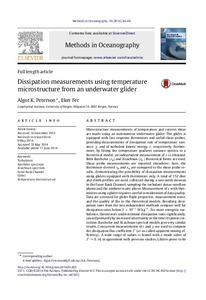| dc.contributor.author | Peterson, Algot K. | |
| dc.contributor.author | Ilker, Fer | |
| dc.coverage.spatial | Faroe Bank Channel | en_US |
| dc.date.accessioned | 2019-04-02T16:19:20Z | |
| dc.date.available | 2019-04-02T16:19:20Z | |
| dc.date.issued | 2014 | |
| dc.identifier.citation | Peterson, A.K. and Ilke, F. (2014) Dissipation measurements using temperature microstructure from an underwater glider.
Methods in Oceanography, 10, pp.44-69. DOI:https://doi.org/10.1016/j.mio.2014.05.002. | en_US |
| dc.identifier.uri | http://hdl.handle.net/11329/893 | |
| dc.identifier.uri | http://dx.doi.org/10.25607/OBP-439 | |
| dc.description.abstract | Microstructure measurements of temperature and current shear are made using an autonomous underwater glider. The glider is equipped with fast-response thermistors and airfoil shearprobes, providing measurements of dissipation rate of temperature
variance, χ, and of turbulent kinetic energy, ε, respectively. Furthermore, by fitting the temperature gradient variance spectra to a theoretical model, an independent measurement of ε is obtained.Both Batchelor (εB) and Kraichnan (εK) theoretical forms are used.Shear probe measurements are reported elsewhere; here, the thermistor-derived εB and εK are compared to the shearprobe results, demonstrating the possibility of dissipation measurements using gliders equipped with thermistors only. A total of 152 dive and climb profiles are used, collected during a one-week mission in the Faroe Bank Channel, sampling the turbulent dense overflow plume and the ambient water above.Measurement of ε with thermistors using a glider requires careful consideration o fdata quality. Data are screened for glider flight properties, measuremen tnoise, and the quality of fits to the theoretical models. Resulting dissipation rates from the two independent methods compare well for dissipation rates below 2×10−7Wkg−1. For more energetic turbulence, thermistors underestimate dissipation rates significantly, caused primarily by increased uncertainty in the time response correction. Batchelor and Kraichnan spectral models give very similar results. Concurrent measurements of ε and χ are used to compute the dissipation flux coefficient Γ(or so-called apparent mixing efficiency). A wide range of values is found, with a mode value of Γ≈0.14,in agreement with previous studies. Gliders prove to be suitable platforms for ocean microstructure measurements, complementary to existing methods. | en_US |
| dc.language.iso | en | en_US |
| dc.rights | Attribution-NonCommercial-NoDerivs 4.0 | * |
| dc.rights.uri | http://creativecommons.org/licenses/by-nc-nd/4.0/ | * |
| dc.subject.other | Turbulence | en_US |
| dc.subject.other | Batchelor spectrum | en_US |
| dc.subject.other | Kraichnan spectrum | en_US |
| dc.subject.other | Glider | en_US |
| dc.subject.other | Temperature microstructure | en_US |
| dc.title | Dissipation measurements using temperature microstructure from an underwater glider. | en_US |
| dc.type | Journal Contribution | en_US |
| dc.description.refereed | Refereed | en_US |
| dc.format.pagerange | pp.44-69 | en_US |
| dc.identifier.doi | https://doi.org/10.1016/j.mio.2014.05.002 | |
| dc.bibliographicCitation.title | Methods in Oceanography | en_US |
| dc.bibliographicCitation.volume | 10 | en_US |
| dc.description.maturitylevel | TRL 5 System/subsystem/component validation in relevant environment | en_US |
| dc.description.bptype | Guide | en_US |
| obps.contact.contactemail | Algot.Petersson@gfi.uib.no | |
| obps.resourceurl.publisher | https://www.sciencedirect.com/science/article/pii/S2211122014000231?via%3Dihub | en_US |
 Repository of community practices in Ocean Research, Applications and Data/Information Management
Repository of community practices in Ocean Research, Applications and Data/Information Management

